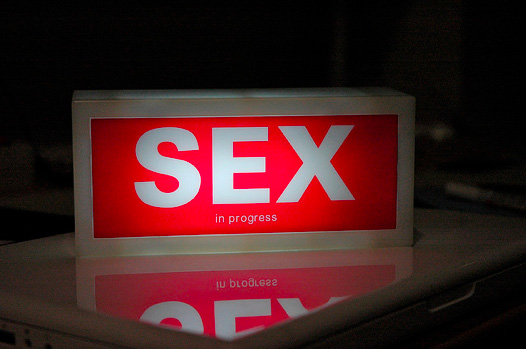
Image courtesy of Flickr Creative Commons
The Ithacan conducted their own version of the NCHA, but they left off questions about disease, injury, violence, mental health, and nutrition, instead choosing to jump right into the dirty, most buzz-worthy details: sex and alcohol!
In attempting to analyze the results of their poll, which essentially concluded that students don’t have as much sex as “everyone else assumes,” The Ithacan failed in their objective to spark a healthy and lively discussion. Instead, readers have spent the last few days critiquing the article – which received the rare distinction of appearing on both the front cover and the cover of the “Accent” (arts & culture) section. There are many problems with the piece, but four components really stick out as elements of irresponsible journalism.
The Article Does Not Define “Sexual Partner”
The Ithacan‘s article – all of the “evidence,” all of the argument, and the poll that sparked the piece itself – hinges on the number of “sexual partners” that a respondent has had. The problem is that it never defines the term. Does a blowjob buddy qualify as a “sexual partner”? Does below-the-belt touching “count” as a sexual encounter? This failure to distinguish between oral, anal, vaginal, and “other” kinds of sex manages to confuse readers, and I’m willing to bet it confused some of the survey’s respondents, too. The NCHA specifically distinguished between different kinds of sex, and it stratified its results accordingly.
The Article Assigns Truth to an Unscientific Survey
I’m not the biggest fan of statistics and surveys – very few are done well, and the numbers can be so easily manipulated or miscommunicated that they’re rarely worth reading. But in any well-composed survey with well-presented findings, the researcher makes sure to analyze large sample sizes by talking about what the results show about the respondents, not what they demonstrate about the entire population.
The Ithacan‘s poll included the responses of 450 Ithaca College students, and the article analyzes those responses as hard-and-fast fact, making weighty comparisons in statistically-insignificant places. It also makes comparisons between genders without informing readers how many male and female respondents, respectively, participated in the poll (from the results, it seems as though the respondent pool skewed slightly female).
For example, one section of the article reads, “While 27.1 percent of women at the college had no sexual partners last semester, only 23.7 percent of men could say the same.” The analysis tries to showcase a significant gendered distinction by comparing 61women to 54 men (if, of course, we assume that an equal number of men and women responded to the poll). If The Ithacan found it so necessary to do a survey like this, they should have consulted with a statistician or some other individual with a greater understanding of polling data and its significance.
The Article’s “LGBT Angle” is Forced and Misguided
The Ithacan tried to be LGBT-inclusive with its “Great Sexpectations” article, and they also attempted to draw comparisons between heterosexuals’ sexual experiences and the sexual experiences of the LGBT community. The problem is that only 72 LGBT students (16 percent of 450) participated in the poll, and analyses such as, “LGBT students are more likely to regret drunken sexual experiences than students who identify as heterosexual,” make sweeping generalizations about an entire community of individuals. Beyond that, The Ithacan’s poll does not stratify the LGBT community into gay, lesbian, bisexual, or trans, and thus, the unique experiences of each part of that community are lumped together and viewed as identical.
Several of the LGBT components of the piece also rely on societal assumptions, many of which I’d never heard before. For example, the piece includes, “Some surveys suggest LGBT alcohol use is not as high as is commonly perceived,” and on the front page of the issue, a tabloidy pull-out graphic reads, “Rumor: LGBT students have more sex.” Who’s making these assumptions?
The Ithacan also botches the LGBT angle when it quotes Garen Whitmore. The line reads, “Sophomore Garen Whitmore, who identifies as gay, said some sexual decisions students make may lead to regret afterward.” Every other student quoted in the article is not qualified with an “identifies as straight” descriptor. Whitmore’s gay identification didn’t need to be specifically spelled out – especially when he discusses his previous boyfriends in his quotation that follows. Specifying in Whitmore’s case assumes heterosexual normality in every other case.
The Article Sends An Overall Sex-Negative Message
In their attempt to be provocative and revelatory about misconceptions regarding students’ sex lives, The Ithacan staff instead produced a story that looks at sex through the lens of shame. There’s a fine line between, “Look, not everyone around you is having sex, so if you’re not either, don’t feel bad!” and “If you have more than three sexual partners, you should feel slutty because you’re in the minority!” Unfortunately, The Ithacan crossed the line by placing particular emphasis on an individual’s number of sexual partners.
A person’s “number” shouldn’t matter, and students shouldn’t feel bad about having six or more sexual partners – just as they shouldn’t feel bad about having zero. Sexual experiences are not something we should feel the need to quantify with a survey, and individuals should not feel the need to regard their sex lives as stressors.
If a work in on-campus or downtown Ithaca media is flawed or leaves you wanting more, email us at buzzsawmag@gmail.com and write a media critique!
(Photo Courtesy of Flickr Creative Commons)
